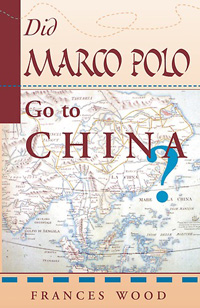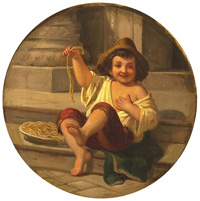"Had Marco Polo actually set foot in China, he could not have possibly missed noticing some rather peculiar local Chinese customs and phenomena such as tea drinking and women binding feet."
CH'NG Poh Tiong's column: Zuo Wang
This latest column is the first of a two-part article on whether noodles were introduced into China from Italy or was it the other way around.
A good starting point to consider the controversy is with the Venetian Marco Polo (c.1254 – 8 or 9 January 1324).

In 1269, Polo (pictured)’s father and uncle, Niccolo and Maffeo, both merchants, returned to Venice from their travels in Asia. They were a long time away and met the 15-year old Marco for the first time.
Another year or two later, when Marco was just 17, the three of them set off again for Asia.
By the time they had reached China, if they actually did reach China, the Mongol Yuan Dynasty (1271-1368) had established itself.
It was another 24 years before Marco Polo returned to Venice, only to find it was now at war with Genoa.
The returnee was imprisoned and dictated his stories to a cellmate. Polo was released four years later in 1299, became a wealthy merchant, married and had three children. He died in 1324 and was buried in San Lorenzo, Florence.
Did Marco Polo actually made it to the Middle Kingdom?
DID MARCO POLO GO TO CHINA?

In 1995, Frances Wood, head of Chinese Department in the British Library published a book entitled Did Marco Polo Go to China? (pictured)
The scholar points out that had Marco Polo actually set foot in China, he could not have possibly missed noticing some rather peculiar local Chinese customs and phenomena such as:
• tea drinking
• binding of women's feet (which first started in the Song Dynasty, 960-1279)
• calligraphy
• the Great Wall of China
Frances Wood thinks Marco Polo never got beyond Persia. His China stay, she suggests, was retold by him with the help of Arab and Persian travellers who had, themselves, visited and traded with China.
For a foreigner neglecting to point out such unusual cultural practices like tea drinking and women binding feet would be as if an alien who visited our planet failing to spot humans spending so much time talking into their mobile phones or staring constantly at their tablets and computers.
It was missing things that were the most obviously different.
Perhaps most glaring of all, Wood points out that Marco Polo is not mentioned in any Chinese records.
This omission is in spite of the fact that Marco Polo claimed to have met Kublai Khan. And that he was a governor of Yangzhou, a very important city.
Given the Chinese propensity for keeping records, Marco Polo not mentioned officially would seem rather odd.
That being the case, Marco Polo as the source of pasta having been introduced into China is very tenuous. Not that I am even suggesting that pasta was introduced to China in the first place.
FIRST MENTION OF PASTA
The first reference to pasta dates back to 1154, in Sicily.
Pasta is made from durum wheat flour mixed with water and formed into sheets or various shapes. It can be made with flour from other cereals or grains and eggs may be used instead of water. Pastas may be dried or fresh.
According to some historians, the Arabs adapted noodles for long journeys in the 5th century. This represents the first written record of dry pasta. Durum wheat was actually introduced by Libyan Arabs during their conquest of Sicily in the late 7th century. The dried pasta introduced was being produced in great quantities in the Sicilian capital Palermo at that time.
As such, we can even say it was the Arabs who first introduced pasta to Italy.
In the 14th and 15th centuries, dried pasta became popular for its easy storage. This allowed people to store dried pasta in ships when exploring the New World.
These then were the world’s first instant noodles. Not Japan’s Nissin Foods’ “Top Ramen” which was invented in 1958 (and, later, cup noodles in 1971).

United States public domain
Compared to highly processed Japanese instant noodles, the earlier Arab dried pasta was healthier because it did not contain any MSG, another dubious Japanese invention.
(Incidentally, in Xinjiang, Muslim people there pack naan bread with them to eat on long journeys).
EATEN WITH FINGERS
The first written record of pasta with tomato sauce can be found in the 1790 cookbook L'Apicio Moderno by Roman chef Francesco Leonardi. Before tomato sauce was introduced, pasta was eaten dry with the fingers (pictured). The liquid sauce demanded the use of a fork. And only rich people could have afforded utensils in the old days.
Tomato originated from Mexico. It spread around the world following the Spanish colonization of the Americas much like the British spreading the fame of Bordeaux wines and cognac to her many colonies including Singapore and, at one time, Hong Kong.
The Italian word for tomato is pomodoro, which translates, literally, as ‘Golden Apple’. The reason is because the first tomatoes that arrived in Italy were yellow in colour (pictured), not red.
Incredibly, today, the largest exporter of tomato sauce back to Italy is Xinjiang.
Italy, however, returns the favour and exports Prada, Gucci, Tod’s, Brioni, Zegna, Maserati, Lamborghini and Ferrari to China.
*NEXT COLUMN – 4,000 year old noodle and wine pairings with some noodle dishes 
Columnist Introduction
A lawyer by training, CH’NG Poh Tiong also holds a Postgraduate Certificate with Distinction in Chinese Art from the School of Oriental & African Studies, University of London. He is an Honorary Ambassador of TEFAF – The European Fine Art Fair – Maastricht. CH'NG works principally as a wine journalist and is publisher of The Wine Review, the oldest wine publication in Southeast Asia, Hong Kong and China since 1991.
Click here to read all articles by CH'NG Poh Tiong>>
- Follow us on Weibo @Decanter醇鉴 and Facebook
and Facebook for the latest news and updates -
for the latest news and updates -
All rights reserved by Future plc. No part of this publication may be reproduced, distributed or transmitted in any form or by any means without the prior written permission of Decanter.
Only Official Media Partners (see About us) of DecanterChina.com may republish part of the content from the site without prior permission under strict Terms & Conditions. Contact china@decanter.com to learn about how to become an Official Media Partner of DecanterChina.com.

Comments
Submit